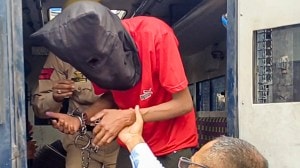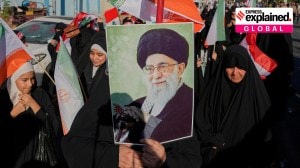Jaipur-Mumbai train shooting: What role does the RPF play in railway security?
Railway Protection Force personnel are deployed for duty at passenger areas, train escorting duties, bandobast duties, evictions, special drives in ladies' compartments and disabled coaches and assistance to ticket checking duties.
 Jawan of Railway Protection Force (RPF) during a rehearsal of the 2015 Republic Day Parade at Rajpath in New Delhi. (Express photo by Praveen Khanna)
Jawan of Railway Protection Force (RPF) during a rehearsal of the 2015 Republic Day Parade at Rajpath in New Delhi. (Express photo by Praveen Khanna) A statement regarding the mental health of Chetan Singh, the Railway Protection Forces (RPF) constable allegedly behind the killing of three men onboard the Jaipur Express on Monday, has been withdrawn by the Railways pending an investigation.
 On Wednesday (August 3), the Railways said that he and his family kept his medical issues a secret from office but it withdrew the statement later, citing an ongoing inquiry. The first release said: “The treatment for the present medical ailment has been taken on his personal level by Chetan Singh and is not in official records… He and his family have kept it a secret.”
On Wednesday (August 3), the Railways said that he and his family kept his medical issues a secret from office but it withdrew the statement later, citing an ongoing inquiry. The first release said: “The treatment for the present medical ailment has been taken on his personal level by Chetan Singh and is not in official records… He and his family have kept it a secret.”Early on Monday, RPF constable Singh, who was on escort duty, allegedly shot dead his senior, ASI Tikaram Meena, and three passengers aboard the Jaipur-Mumbai Central Superfast Express. The passengers were identified as Asgar Abbas Ali from Madhubani in Bihar; Abdul Kadar Mohamed Hussain Bhanpurwala (64) from Nalasopara in Palghar, Maharashtra; and Syed Saifullah (43) from Nampally in Hyderabad.
RPF officials — like other railway officials — undergo periodic medical examinations (PME) every five years to test their fitness for the job. “In the last PME, no such medical ailment/condition was detected,” the Railways’ initial statement said. Around two hours later, the Railways deleted the statement and said a high-level committee has been set up to look into these aspects.
Psychoanalysis of RPF personnel, to make sure they are mentally fit to carry firearms on duty, is being considered while the high-level committee probes the killings. Officials could not clarify if there are specific tests periodically to detect mental health issues in RPF personnel.
The incident has now turned the attention to the RPF – the gun-wielding men and women in khaki who are mandated to protect railway assets across India.
What is RPF and why was it formed?
In 1957, the Railway Protection Force Act was passed to organise a force that would watch over railway assets in India. Before that the forces have been in existence in various avatars since the 19th Century to protect railway systems, ever since trains started in India.
The smaller railway companies that existed in the 18th and 19th Centuries across India, for the country’s railway network, deployed their personnel for the protection of assets and “Watch and Ward” duties. They have been called various names, like “Company Police” and others.
“It was decided in consultation with the Ministry of Home Affairs that there should be an integrated well-organised force on the model of the Police with adequate supervisory staff specially trained to meet the particular aspects of crime that were relevant to Railway property and to work in close collaboration and act as a second line to the States Police with whom, under the Constitution, policing on Railways rested,” says Indian Railways’ own documented history on the RPF.
RPF was also given limited legal powers under the Railway Stores (Unlawful Possession) Act of 1966. This means it can search, arrest, and prosecute under the provisions of this Act as well as the Railway Act, 1989, making it a comprehensive security force for the railway system.
The powers to arrest under any other penal laws rests with the state police or the Government Railway Police, since law and order, Railways maintains, is “a state subject”.
How are they deployed?
They are deployed for duty at passenger areas, train escorting duties, bandobast duties, evictions, special drives in ladies’ compartments and disabled coaches and assistance to ticket checking duties.
Special Forces
During the China War in 1962, India decided to maintain the communication lifeline of Railways for the transportation of men and materials to the front and relieve the Army, extracting men and officers from the existing RPF Armed Wing on Railways. This Special Emergency Force was later renamed Railway Protection Special Forces (RPSF).
They undergo intensive training and remain in a state of readiness to move out at short notice. Today, RPSF is deployed to safeguard railway operations in security-sensitive areas like Jammu and Kashmir, Northeast, Left Wing Extremism-affected areas and the like. The RPF also has a small “commando” force called CORAS.
How large is the force?
The RPF is around 61,000 strong, against a sanctioned strength of 74,830 personnel. Around 10 per cent of its personnel are women, which is among the highest in paramilitary forces.
The officers are inducted through Railway Protection Force Service, a Group A service inducted from the UPSC Civil Services examination. It is headed by a Director General, who is usually an Indian Police Service (IPS) officer in the rank of a Secretary to the Government of India.
Guns and RPF
RPF personnel on duty at the Chhatrapati Shivaji Terminus in Mumbai on the fateful night of the 26/11 terror attacks had later received the President’s Police Medal for gallantry for putting up a brave fight against the terrorists, including Ajmal Kasab. They were armed with vintage .303 rifles, whereas the terrorists had automatic AK-47s.
After the carnage, the government took a decision to modernise the weaponry of the Railway Protection Force.
The Director General of RPF periodically issues the Standing Order authorising the carriage of firearms — how many to carry and what kind — by RPF personnel.
The degree of the need for firearm-aided security may vary from zone to zone. Accordingly, the order authorises weapons as a percentage of the sanctioned strength. So, for one zone it may be 50 per cent while for another it may be 65 per cent. For the RPSF, it is usually 100 per cent.
As with any armed force, the RPF is equipped with pistols, revolvers, carbines (9mm), rifles like INSAS, AK-47, SLRs, Light Machines Guns and the .303s.
What type of firearms can be carried by a certain amount of personnel, of a particular rank, is also mandated by the order.
How are the personnel tested for fitness?
Every RPF personnel undergoes a comprehensive Periodic Medical Examination every five years until the age of 45 years and every three years after that. Doctors test them against various laid down parameters to certify their fitness for duty. The RPF has its own training centres where medical tests are carried out every year, and personnel have to pass periodic tests of firing as well.


































